|
County Fermanagh.
BY F. J. COLE.
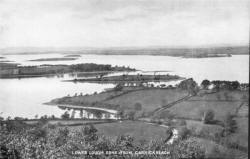 |
|
LOWER LOUGH ERNE |
" And I shall have some peace there, for peace comes dropping slow,
Dropping from the veils of the morning to where the cricket sings ;
There midnight's all a glimmer, and noon a purple glow, And evening's
full of the linnet's wings."
-W. B. YEATS.
COUNTY FERMANAGH derives its name from FIRMONACH the men of MONACH, a
Leinster tribe of which some members settled around the shores of Lough
Erne early in the Christian era. Bounded on the east by Tyrone and
Monaghan, on the north by Tyrone, on the north-west and west by Donegal,
and on the south-west and south by Leitrim and Cavan, Fermanagh is
completely divided by its two great lakes.
Lough Erne.
The river which forms the main source of these rises in Co.
Longford, and after passing through Co. Cavan to the southern border of
Ulster and of Co. Fermanagh, unites with two other rivers to form Upper
Lough Erne, a lake about 15 miles in length, and 4 miles in breadth.
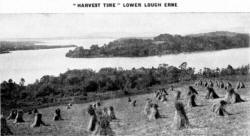 At its northern extremity Upper Lough Erne narrows into a channel around
the island on which Enniskillen is built, and about a mile to the
north-west of that town the channel broadens into the magnificent sheet
of water known as Lower Lough Erne, which is about 20 miles in length,
and at its widest point about 7 miles in breadth. Near the western
border of the county this lake again narrows into a river before its
waters enter on their final journey past Belleek and Ballyshannon into
the Atlantic Ocean. With a navigable course of over fifty miles amongst
scores of islands, many of which are covered with trees and luxuriant
foliage to the water's edge, Upper and Lower Lough Erne, as well as the
adjoining lakes of Macnean and Melvin, present to the yachtsman and the
oarsman, as well as to the motorist and the pedestrian, scenes of
unrivalled beauty. "The beauty of Ireland is the beauty of its waters,
says Mr. Stephen Gwynn, and these words are singularly appropriate when
applied to the Lake district of Ulster. The tranquil beauty of the
wooded islands as they stud the placid bosom of Lough Erne, the
exquisite settings of the sylvan scenes which surround the sun-kissed
waters, the purple heaths which crown the wild declivities, the grey
rocks, and storm pitted cliffs combine each with the other to create a
veritable dream of loveliness. In few counties do the territorial
families maintain their mansion houses and demesne lands in keeping with
family traditions to the same extent as in Fermanagh, contributing
thereby to the well-being of the district, and adding to the charm of
lake and countryside by the profuseness of the woods and plantations.
Amidst such surroundings it would be difficult to find more effective
settings for the many ruined and picturesque castles whose weatherworn
and war-scarred battlements reflect the turbulent history of the Ulster
Plantation. At its northern extremity Upper Lough Erne narrows into a channel around
the island on which Enniskillen is built, and about a mile to the
north-west of that town the channel broadens into the magnificent sheet
of water known as Lower Lough Erne, which is about 20 miles in length,
and at its widest point about 7 miles in breadth. Near the western
border of the county this lake again narrows into a river before its
waters enter on their final journey past Belleek and Ballyshannon into
the Atlantic Ocean. With a navigable course of over fifty miles amongst
scores of islands, many of which are covered with trees and luxuriant
foliage to the water's edge, Upper and Lower Lough Erne, as well as the
adjoining lakes of Macnean and Melvin, present to the yachtsman and the
oarsman, as well as to the motorist and the pedestrian, scenes of
unrivalled beauty. "The beauty of Ireland is the beauty of its waters,
says Mr. Stephen Gwynn, and these words are singularly appropriate when
applied to the Lake district of Ulster. The tranquil beauty of the
wooded islands as they stud the placid bosom of Lough Erne, the
exquisite settings of the sylvan scenes which surround the sun-kissed
waters, the purple heaths which crown the wild declivities, the grey
rocks, and storm pitted cliffs combine each with the other to create a
veritable dream of loveliness. In few counties do the territorial
families maintain their mansion houses and demesne lands in keeping with
family traditions to the same extent as in Fermanagh, contributing
thereby to the well-being of the district, and adding to the charm of
lake and countryside by the profuseness of the woods and plantations.
Amidst such surroundings it would be difficult to find more effective
settings for the many ruined and picturesque castles whose weatherworn
and war-scarred battlements reflect the turbulent history of the Ulster
Plantation.
Enniskillen.
Previous to the reign of James I. Enniskillen, the capital of Fermanagh,
was a stronghold of the Maguires, the chieftains of Fermanagh, one of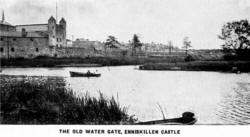 whose castles stood on an island in the river connecting Upper with
Lower Lough Erne. The old name of this island was Innis Cethlen, or
Cethlen's Island, thought to have been so called from Cethlen, wife of
Balor of the Mighty Blows, one of the mythical Fomorian Kings of
Ireland. In 1607 we find William Cole in possession of a castle as its
captain and warden, and between 1611 and 1613 the advantage of the
situation induced James I. to make him considerable grants of land,
including one-third of the island of Inniskilling, on condition that he
thereon built a town and settled twenty British families, who were to be
incorporated as burgesses. This castle was situated to the west of the
town in what is now called the Castle Barracks, and of it very little
remains except a turreted gateway which may be seen on the river side.
whose castles stood on an island in the river connecting Upper with
Lower Lough Erne. The old name of this island was Innis Cethlen, or
Cethlen's Island, thought to have been so called from Cethlen, wife of
Balor of the Mighty Blows, one of the mythical Fomorian Kings of
Ireland. In 1607 we find William Cole in possession of a castle as its
captain and warden, and between 1611 and 1613 the advantage of the
situation induced James I. to make him considerable grants of land,
including one-third of the island of Inniskilling, on condition that he
thereon built a town and settled twenty British families, who were to be
incorporated as burgesses. This castle was situated to the west of the
town in what is now called the Castle Barracks, and of it very little
remains except a turreted gateway which may be seen on the river side.
Florence Court.
Captain William Cole was ancestor of the Earls of Enniskillen, and since
1756 the family have resided in the palatial mansion of Florence Court,
which, with a frontage of 260 feet, is probably the finest mid-Georgian
mansion in Northern Ireland.

The Royal School.
In 1618, under Royal Charter, there was founded the celebrated
Royal School of Enniskillen. At first carried on at Lisnaskea, the
school was subsequently transferred to Enniskillen. In 1777 the main
portion of the present building, which has since been largely added to,
was erected in the beautiful Enniskillen suburb of Portora. Many Portora
boys have become famous, amongst such being the first Lord Plunkett,
Rev. H. F. Lyte (author of "Abide with Me"), Archbishop Magee, of
Dublin, and the brilliant but unfortunate Oscar Wilde.
The Enniskillen Regiments.
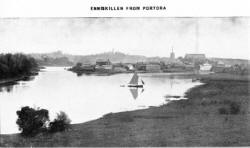 During the Revolution of 1689 the residents of Enniskillen, who were
mainly the Protestant descendants of English and Scotch settlers,
learning During the Revolution of 1689 the residents of Enniskillen, who were
mainly the Protestant descendants of English and Scotch settlers,
learning
that two companies of infantry belonging to the army of James II. were
to be quartered on the inhabitants, decided on resistance, and, in an
engagement fought outside the town, were successful in dispersing the
invading forces. Throughout the remainder of this campaign Enniskillen
was held for William III., under the governorship of Gustavus Hamilton,
a Fermanagh gentleman of Monea Castle. From the men who fought for
Enniskillen at this time there subsequently developed those well-known
regiments of the British Army, the 6th Inniskilling Dragoons and the
Royal Inniskilling Fusiliers, regiments which have brought fame to
Enniskillen throughout the British Empire.
The Cathedral.
The Protestant Cathedral of the Diocese of Clogher, formerly the Parish
Church of Enniskillen, with nave, chancel and side aisles, built in 1842
on the site of an older church, contains a statue to the memory of
General the Hon. Sir Galbraith Lowry Cole, G.C.B., Commander of the 4th
Division during the Peninsular War.
The three guidons of the Inniskilling Dragoons and the colours of the
Inniskilling Fusiliers are deposited here.
War Memorials.
In Belmore Street will be seen two handsome War Memorials ; one in
memory of the Fermanagh men who made the supreme sacrifice in the
Great War, and the other commemorative of the officers and men of the
Inniskilling Dragoons and Inniskilling Fusiliers who fell in the last
South African War.
Enniskillen is fortunate in having a well laid out public park, known as
Forthill. This contains a magnificent pillar and statue erected to
General the Hon. Sir Galbraith Lowry Cole, G.C.B., which can be seen at
considerable distances from the town.
Fermanagh Celebrities.
Amongst the Fermanagh men who became famous abroad were Dr. Wm.
Irvine, born in Enniskillen in 1741, who raised and equipped the 6th
Pennsylvania Regiment, and was in command of the North Western Frontier
during the American War of Independence, also Colonel Francis Nichols,
born at Crieve Hill, Co. Fermanagh, 1737, who achieved distinction at
the same time.
Castle Coole.
One of the stateliest residences in Ireland is Castle Coole, seat of the
Earl of Belmore. Surrounded by a well wooded demesne of 1,500 acres,
which is much admired by visitors entering Enniskillen via road from
Belfast and Dublin, the mansion was erected at the beginning of the
nineteenth century, and is built of Portland stone, which in the
wholesome air of Co. Fermanagh has retained its wonderful whiteness. It
is stated the cost was �54,000, a princely sum at that period.
It would be difficult to imagine a more charming or romantic district
for the holiday-maker than can be found in the neighbourhood of
Enniskillen, and visitors will, therefore, regard that town as a
convenient centre from which to arrange their itineraries. The
respective train and bus services concentrate on the town where there
are excellent hotels such as the Imperial and the Royal, as well as the
prettily situated Lough Erne Hotel at Killadeas, about seven miles
distant.

Lake Drive.
No one who desires to see Fermanagh can omit the magnificent drive
around the shores of Lower Lough Erne, and as the distance via Belleek
is only fifty seven miles over excellent roads, the journey can be done
in a few hours. Leaving Enniskillen at the eastern end the motorist
bears left at the South African War Memorial, and after a few miles
passes Trory Church, ' Rossfad,' the residence of Colonel Richardson, '
St. Angelo,' the residence of the Bishop of Clogher. the Lough Erne
Hotel at Killadeas, and later the village of Lisnarick and Castle
Archdale, with its pretty church adjoining the road. Castle
Archdale.
In the early years of the 17th century Irish roads were few and
travelling was dangerous ; in consequence, the undertakers of the Ulster
Plantation quickly recognised the advantage afforded by residence on a
great watery highway like Lough Erne, which provided a method of
communication which was speedy and secure. Many of the sites then chosen
for the Plantation castles are remarkable for their beauty, and, in this
respect, it would be difficult to find a more picturesquely situated
ruin than that of the original Castle Archdale, which is a fine example
of the architectural design of the period. The modern castle, a noble
structure, is the home of Lieut.-Colonel J. B. Archdale, D.L. After
passing Castle Archdale, the motorist is recommended to leave the main
road for a little, and keep tothe left by the Clareview road. As this is
an old high-way and somewhat narrow, drivers are advised to exercise
care, but the entrancing view, which is quickly obtained, of White
Island and its surroundings on Lough Erne, will well repay any
inconvenience caused by the quality of the road.
Crevenish Castle.
Continuing by this route Crevenish Castle, another Plantation
residence, is passed on the left before reaching the village of Kesh.
Crevenish was built by Thomas Blennerhasset, early in the seventeenth
century. During the outbreak of 1641 Captain Rory Maguire, brother of
Lord Maguire, who was executed at Tyburn Hill for complicity in the
insurrection, resided here through having married Lady Deborah
Blennerhasset. On reaching the village of Kesh, the main road to Belleek
is again resumed, and two miles later the splendid new bridge is crossed
into Boa Island, which is four miles in length. Castle
Caldwell.
Leaving Boa Island and proceeding five miles further, near Castle
Caldwell Railway Station will be seen the well-known fiddle stone, with
its quaint reminder of the fate that befell the fiddler in 1770. " On
firm land only. Exercise your skill.
There you may play and safely drink your fill."
Belleek.
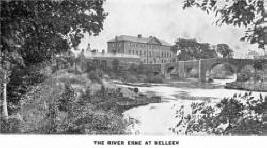 Should it be desired at this point to shorten the return journey to
Enniskillen, the new Rosscor Bridge can be crossed to the southern shore
of the lake, but if possible it is advisable to continue the journey to
Belleek (the ford mouth of the flag stone), where visitors can arrange
to inspect the beautiful productions of the celebrated porcelain factory
which was originally founded by Mr. J. C. Bloomfield, D.L., of Castle
Caldwell, through the enterprise of the late Mr. McBirney, of Dublin. An
opportunity may also be taken of seeing the great sluice gates, which
control the level of Lough Erne. As a fishing resort, Belleek is one of
the most popular and convenient centres in Fermanagh, and is well
supplied with excellent hotels. Proceeding from Belleek on the return
journey to Enniskillen by the southern shore of the lake, motorists
should note that the first few hundred yards of road between Belleek
Bridge and the British Customs Hut are in the Irish Free State, and that
while permission is granted by the Free State authorities to use this
road, motorists must not stop until they have crossed into Northern
Ireland territory. Should it be desired at this point to shorten the return journey to
Enniskillen, the new Rosscor Bridge can be crossed to the southern shore
of the lake, but if possible it is advisable to continue the journey to
Belleek (the ford mouth of the flag stone), where visitors can arrange
to inspect the beautiful productions of the celebrated porcelain factory
which was originally founded by Mr. J. C. Bloomfield, D.L., of Castle
Caldwell, through the enterprise of the late Mr. McBirney, of Dublin. An
opportunity may also be taken of seeing the great sluice gates, which
control the level of Lough Erne. As a fishing resort, Belleek is one of
the most popular and convenient centres in Fermanagh, and is well
supplied with excellent hotels. Proceeding from Belleek on the return
journey to Enniskillen by the southern shore of the lake, motorists
should note that the first few hundred yards of road between Belleek
Bridge and the British Customs Hut are in the Irish Free State, and that
while permission is granted by the Free State authorities to use this
road, motorists must not stop until they have crossed into Northern
Ireland territory. The fascinating and fairy-like beauty which
presents itself on the 22 miles run from Belleek to Enniskillen can be
but faintly sketched by pen or pencil. Motorist, cyclist and pedestrian,
will readily agree with the celebrated traveller, Harry De Wint, who
once said :�"Nothing in Great Britain, perhaps nothing in Europe, can
surpass the beauty of the whole road that leads to Enniskillen."

Tully Castle.
About 12 miles from Belleek will be seen the picturesque ruins of
Tully Castle, built by Sir John Hume, and said to have been burnt in
1641 by Captain Rory Maguire. Nearer Enniskillen the well-wooded lands
of Ely Lodge, residence of Lord Loftus and Castle Hume, add a pleasing
feature to this part of the journey. Devenish.
Of the ancient ecclesiastical remains in Fermanagh those on the island
of Devenish in Lower Lough Erne, are the most important. Founded in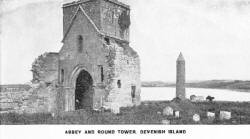 the
sixth century by St. Molaise, the oldest remaining building is the
little ruined church built in that early style described as cyclopean
and which is known as Molaise's House. Originally a stone-roofed
edifice, the roofing stones were somewhat ruthlessly removed early in
the nineteenth century. The beautiful carving of the pilaster quoins was
probably done some centuries after the date of erection. Although not
the oldest, the most attractive feature is the Round Tower. Primarily
used as belfries, and secondarily as storehouses for the preservation of
the monastic treasures during the Danish invasions, none of the Irish
Round Towers retains its original beauty and perfection to a greater
degree than the Devenish example. With a total vertical height of 81
feet 4i inches, the tower was originally divided into five stories, each
floor being lighted by a small window, except the upper which has four
windows facing the cardinal points. A feature of this tower is its
richly sculptured cornice, under the cap, which displays four carved
human heads over the four windows which may represent Saints Patrick,
Columba, Molaise, and Brigid. The Old Abbey or TEAMPUL MOR, the great
church, was probably erected in the twelfth century, and extended at
later dates. A feature is the deeply embayed arched window in the south
wall, near which is the mausoleum of a branch of the Maguire family. the
sixth century by St. Molaise, the oldest remaining building is the
little ruined church built in that early style described as cyclopean
and which is known as Molaise's House. Originally a stone-roofed
edifice, the roofing stones were somewhat ruthlessly removed early in
the nineteenth century. The beautiful carving of the pilaster quoins was
probably done some centuries after the date of erection. Although not
the oldest, the most attractive feature is the Round Tower. Primarily
used as belfries, and secondarily as storehouses for the preservation of
the monastic treasures during the Danish invasions, none of the Irish
Round Towers retains its original beauty and perfection to a greater
degree than the Devenish example. With a total vertical height of 81
feet 4i inches, the tower was originally divided into five stories, each
floor being lighted by a small window, except the upper which has four
windows facing the cardinal points. A feature of this tower is its
richly sculptured cornice, under the cap, which displays four carved
human heads over the four windows which may represent Saints Patrick,
Columba, Molaise, and Brigid. The Old Abbey or TEAMPUL MOR, the great
church, was probably erected in the twelfth century, and extended at
later dates. A feature is the deeply embayed arched window in the south
wall, near which is the mausoleum of a branch of the Maguire family.
St. Mary's Abbey retains many traces of its architectural splendour. The
quadrangular belfry tower, and the groining of its vault, together with
the decorated pointed door in the northern wall are worth inspection.
The cloister and the Abbey buildings lay to the north of this church.
South of the Abbey is a somewhat remarkable type of ornamental cross
with the crucifixion in relief carved on its eastern side. If time
permits antiquarians might also visit White Island, with its Romanesque
door and curious sculptured figures. Lough Eyes.
Five miles from Enniskillen is the village of Lisbellaw, near which on
Lough Eyes may be seen a number of crannogs or lake dwellings.
Lisnaskea.
Six miles to the south west of Lisbellaw is Lisnaskea, which was one of
the inauguration places of the Maguire chieftains, and where Sir James
Balfour built his castle in 1615. Crom Castle.
Six miles further south is the Earl of Erne's demesne and
castle of Crom, where will be seen the remains of the charmingly
situated old castle which twice withstood the sieges of the army of King
James II. Close by is a yew tree of gigantic dimensions. Visitors are
usually admitted here on Fridays. The Marble Arch.
No more delightful excursion can be arranged than one to the
Marble Arch, two miles from Florencecourt, for which permits should be
obtained from the Estate Office, Middleton Street, Enniskillen.
Approached through a glen of great beauty, the Arch is the mouth of an
underground river, which after flowing through unknown caverns here
returns to the light of day. With the aid of a canvas boat some of these
caves were explored by Martel, the French speleologist, accompanied by
the late Dr. H. Lyster Jameson. A short distance from here, at Gortatole,
is a splendid mountain road, with magnificent panoramic views of Upper
and Lower Lough Macnean, as well as of Cuilcagh Mountain, where the
River Shannon rises. Close to this road are three cashels.

Doohat
Monument.
On the eastern slopes of Benaughlin Mountain, at a distance of about
half a mile from the Enniskillen�Swanlinbar road, is the celebrated star
shaped monument of Doohat to the south of which at a distance of a few
yards is a horned cairn. the whole suggesting a star and crescent.
Boho.
Amongst the most accessible of the Fermanagh caves are those
at Boho, about six miles from Enniskillen. Colonies of Daubenton's bat
may here be found.
Knockmore.
Several other caves may be explored in this district, while at
Knockmore, near the village of Derrygonnelly, are caves on whose walls
will be seen scribings or carvings believed to be the work of primitive
man. Knockninny.
No finer view of Upper Lough Erne can be obtained than from Knockninny
Hill, ten miles south of Enniskillen. Here also will be found a cave
used as a sepulchre by early man, while on the summit are three
prehistoric cairns, and at short distance two "Giants GGraves" of the
dolmen type. Bellisle.
Looking in a north westerly direction the beautiful island of
Bellisle will be seen. In the monastery which once stood on this island
Cathal Maguire, who died in 1498, compiled " The Annals of Ulster."
Garrison.
No Fermanagh holiday should conclude without a visit to Garrison, the
haunt of Isaac Walton's disciples on the beautiful Lough Melvin, and if
this is approached through Belcoo very fine views will be obtained of
Upper and Lower Lough Macnean. Belcoo.
The ancient churches of Templenaffrin (the church of the Mass), and
Holywell are passed near Belcoo, and in both of these the antiquary will
find points of interest.
 LONDONDERRY.
" THE MAIDEN CITY."
BY THE VERY REV. R. G. S. KING. M.A..
Dean of Derry.
LONDONDERRY
VISITORS to Ulster should not fail to spend a portion of their
itinerary in the ancient and historic City of Londonderry, the
Walls of which, erected in 1617, and still in perfect
preservation, are surmounted by the ordnance which enabled its
heroic defenders to repel the assaults of the enemy during the
ever memorable Siege of 1688 and 1689, of which the golden pens
of Macaulay, Reid, Witherow, and Lecky have left undying
records. Visit its beautiful Guildhall, which contains a most
magnificent range of historical stained glass windows, Statuary,
and a very fine Organ, built by Messrs. Hill & Sons, London, to
the specification of the late Sir Walter Parratt. Inspect its
War Memorial, one of the most artistic in the Kingdom. Enter the
Cathedral of St. Columb, erected in the year 1633, and replete
with memorials of the Siege ; ascend its Tower, from which in a
clear atmosphere a charming view may be obtained of the City and
surrounding country, together with the windings of the River
Foyle, and in the distance Lough Foyle and the Innishowen
Headlands. In the Churchyard which surrounds the Cathedral may
be seen the "Apprentice Boys' Mound," wherein repose the ashes
of the mighty dead. St. Eugene's Roman Catholic Cathedral, an
ornate and impressive building and one of the largest in
Northern Ireland, should be visited. This Cathedral, the
foundation stone of which was laid in 1851, was completed in
1906 by the erection of a bell tower and lofty spire. In the
Churchyard of Long Tower is St. Columba's Stone, on which the
Saint is said to have kneeled in prayer. In addition to the
foregoing are a number of fine Churches attached to the
Presbyterian
and Methodist denominations
.
.......................................................................................................
The London and Midland and Scottish Railway connect. Londonderry
wan Belfast, and also with South and West Donegal.
The Great Northern Railway of Ireland connects Londonderry with
Baited and Dublin.
The Londonderry and Lough Swilly Railway connects Londonderry
with North and West Donegal.
..................................................................................................................
Guide to the City can he obtained from the Town Clerk.
Guildhall, upon receipt of' stamped addressed envelope. |
Were the tribute of all Alba mine,
From the centre to the border,
I would prefer the site of one house
In the middle of fair Derry."
History.
Derry, so called from the oaks with which the banks of the Foyle here
were anciently clad, was founded by S. Columba in 546. This famous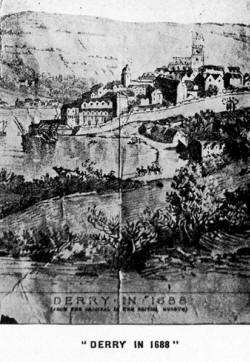 missionary Saint, through whose labours and those of his followers
Scotland and Northern England were converted to Christianity, was born
at Gartan, Co. Donegal, on December 7th, 521. He was a member of the
reigning family of Ireland and of British Dalriada. Censured by an Irish
Synod for having stirred up strife, he left his country, with 12
companions, in the year 563 and settled in (Hy) Iona off the coast of
Scotland. But to the end, his love for Derry was intense, and the
extract opening this chapter is taken from one of his poems written long
after his departure.
missionary Saint, through whose labours and those of his followers
Scotland and Northern England were converted to Christianity, was born
at Gartan, Co. Donegal, on December 7th, 521. He was a member of the
reigning family of Ireland and of British Dalriada. Censured by an Irish
Synod for having stirred up strife, he left his country, with 12
companions, in the year 563 and settled in (Hy) Iona off the coast of
Scotland. But to the end, his love for Derry was intense, and the
extract opening this chapter is taken from one of his poems written long
after his departure.
 No traces of his monastery remain, the site of
which is now occupied by the Long Tower Roman Catholic Church. Here also
stood the ancient Cathedral, the Temple More (i.e., Great Church), built
in 1164. A Cistercian Nunnery was built on the south side of the city in
1218, a Dominican Abbey and Church on the north side in 1274, and
Augustinian Friary and Church. where S. Augustine's Church now stands,
about the end of the 13th century, and a Franciscan Friary, the date of
which is uncertain, where Abbey Street now runs. S. Brecan's Church
inside the grounds of S. Columb's, at the Waterside. is the most ancient
ruin inside the city boundary. It was used by Primate Colton at his
visitation in 1397 Unfortunately Derry proved attractive to the Danes
both on account of its ecclesiastical treasures and its safe harbourage.
The Irish Annals record number of their onslaughts between 832 and 1100.
They also relate the burning of the city or at least seven occasions by
accident or in strife before the year 1200. After the Danes came the
Anglo - Normans whose mania for plundering churches is frequently
referred to by the old annalists. In 1195, 1197 and 1198 John de Courcy
and Rotsel Peyton plundered the churches of Derry
But, alas, our own countrymen were little better, for in 1197 a Mac Etig
of Co. Derry robbed the altar of the Cathedral of "the four richest
goblets in Ireland," and in 1213 Thomas MacUchtry and Rory MacRandal
from Coleraine plundered the town. After the de Courcys came in the 13th
century de Lacys, and in the 14th de Burgos, who built fortresses�Green
Castle. White Castle, etc.�on the shores of Lough Foyle. In 1566,
during the Rebellion of Shane O'Neill, Derry was chosen for the
headquarters of the forces sent against him. But on April 24, 1568, the
magazine which contained ammunition for the English Army in the north
blew up, destroying the town and fort, and causing great loss of life.
After this it was abandoned by the military until 1600, when Sir Henry
Docwra. sent by Queen Elizabeth, selected it as the site of his camp.
Docwra built a fort at Culmore, and another five miles up the river, at
Dunnalong, to protect his camp and the city which he proposed to build.
He was actually constituted Provost for life of the City of Derry in
1604, by a charter of King James I., but shortly afterwards left the
district. His successor, Sir George Paulett, having by his in-justice
and insults goaded Sir Cahir O'Doherty, the young chief of Inishowen,
into rebellion, was surprised and slain by Sir Cahir, and the city once
more laid in ruins. After the suppression of this rising, King James
began to entertain projects for the plantation of the district with
settlers from England, with the result that in 1613 he formed by charter
a new county, to be called the County of Londonderry, and to comprise
all the old County of Coleraine, part of the County of Tyrone, part of
the County of Antrim (Coleraine and its liberties), part of the County
of Donegal (Derry and its liberties), and also the whole of Lough Foyle,
with the ground or soil thereof, from the high seas unto the town of
Lifford. The charter also created the Borough and Corporation of the
City of Londonderry. It conveyed the whole county thus formed to "six
and twenty honest and discreet citizens of our City of London" who shall
be and shall be called " The Society of the Governor and Assistants,
London, of the new plantation in Ulster, within the realm of the Kingdom
of Ireland." Thus the name of the city was changed to Londonderry, and
thus the Irish Society was formed to promote religion, education and
industry in the newly constituted county.
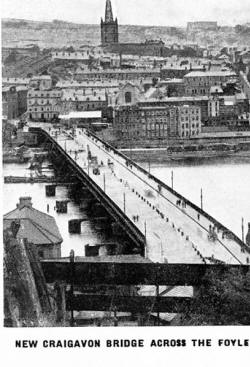 The Governor of the Irish
Society must be an Alderman of the City of London. The Recorder of
London is ex-officio a member of the Society, and the twenty-four
Assistants are Aldermen or Common Councillors of the city. The Society
divided the agricultural land among twelve great London companies�the
Grocers, Merchant Tailors, Drapers, Vintners, Goldsmiths, etc., some of
whom sub-divided portions of their shares with the smaller companies so
that some 40 London companies were concerned with the plantation of the
county. But the Irish Society retained in their own hands the towns of
Londonderry and Coleraine and the valuable fisheries on the Foyle and
Bann, which they hold to this day. They are the ground landlords of
these towns, they own the Walls of Derry, and they visit and inspect
their property every year. The Governor of the Irish
Society must be an Alderman of the City of London. The Recorder of
London is ex-officio a member of the Society, and the twenty-four
Assistants are Aldermen or Common Councillors of the city. The Society
divided the agricultural land among twelve great London companies�the
Grocers, Merchant Tailors, Drapers, Vintners, Goldsmiths, etc., some of
whom sub-divided portions of their shares with the smaller companies so
that some 40 London companies were concerned with the plantation of the
county. But the Irish Society retained in their own hands the towns of
Londonderry and Coleraine and the valuable fisheries on the Foyle and
Bann, which they hold to this day. They are the ground landlords of
these towns, they own the Walls of Derry, and they visit and inspect
their property every year.
The building of a city here was no easy task and proceeded slowly. The
Walls, happily preserved entire, were completed by 1619 at a cost of
8,357. In 1628 the commissioner sent by the King to enquire how far the
Irish Society had complied with their undertakings reported that 265
houses had been built within the Walls. In 1633 S. Columb's Cathedral
was completed. In 1641 the country was again in a state of warfare and
bloodshed. The city was crowded with refugees. From these and from the
inhabitants seven regiments were formed, which kept the enemy at a
distance, and preserved the country around from the massacres which
occurred in other northern counties. In 1649 the city suffered from a
siege lasting twenty weeks, being held by Sir Charles Coote for the
Parliament, and besieged by Lord Montgomery of the Ardes and General
Robert Stewart, leaders of the Royal forces. Coote hired Owen Roe
O'Neill to come to his assistance and compelled the besieging forces to
withdraw.
 In 1688 the Earl of Tyrconnel sent over to England to
support the cause of King James II. the best troops then in Ire-land,
amongst the number,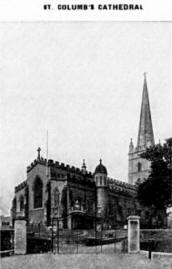 those who garrisoned Derry. Lord Antrim was ordered
to occupy the city with his regiment, but was delayed by the difficulty
of getting sufficient recruits. Meanwhile the citizens were alarmed by
rumours of an impending massacre, similar to that of 1641. When Lord
Antrim's regiment arrived on December 7th, and was being ferried across
the river, two officers entered the city, demanding admission and
billets for the troops. There was a hot debate in the Corporation, and
considerable delay ensued. The soldiers, waiting outside, were becoming
impatient, when the young men of the city took the matter into their own
hands, overpowered the guards, locked the gates, and threatened to fire
on the advancing soldiers, which caused them hastily to retreat. After
this daring exploit, the citizens took stock. they found their cannon
illmounted and without ammunition, they had only 300 men within the city
who had ever borne arms, and they had few weapons for those who had
experience of war ; however, they set to work to repair the
fortifications and to procure what arms, ammunition and assistance they
could: On the 18th of April, 1689, King James and his army invested the
city. James fled, when having advanced contrary to the terms of an
armistice, a cannon fired from the Cathedral Tower killed an officer and
several men near him. Then commenced what Lord Macaulay terms "the most
memorable siege in the annals of the British Isles." To his history we
must refer those wishing to learn the particulars of that heroic defence
which has made the city famous. The siege lasted 105 days, 7,000 persons
perished within the walls, and the defenders were reduced to the last
extremities of starvation. On the 28th of July three relieving ships
with the Dartmouth, a man-of-war, entered the river at Culmore, the
Mountjoy leading. An immense boom of floating beams roped together, was
cut by the crew of the longboat of the Swallow, the Mountjoy striking
the severed boom ran ashore and was subjected to heavy fire from the
forts at each end of the boom, her commander, Captain Browning and
several of the crew being killed, but the rising tide, aided by the
recoil of her guns, floated her off, and with the other ships, the
Jerusalem and the Phoenix, she arrived at the Quay at 10 o'clock at
night. The besieging forces marched off on August 1st, burning every
church and house on their way. those who garrisoned Derry. Lord Antrim was ordered
to occupy the city with his regiment, but was delayed by the difficulty
of getting sufficient recruits. Meanwhile the citizens were alarmed by
rumours of an impending massacre, similar to that of 1641. When Lord
Antrim's regiment arrived on December 7th, and was being ferried across
the river, two officers entered the city, demanding admission and
billets for the troops. There was a hot debate in the Corporation, and
considerable delay ensued. The soldiers, waiting outside, were becoming
impatient, when the young men of the city took the matter into their own
hands, overpowered the guards, locked the gates, and threatened to fire
on the advancing soldiers, which caused them hastily to retreat. After
this daring exploit, the citizens took stock. they found their cannon
illmounted and without ammunition, they had only 300 men within the city
who had ever borne arms, and they had few weapons for those who had
experience of war ; however, they set to work to repair the
fortifications and to procure what arms, ammunition and assistance they
could: On the 18th of April, 1689, King James and his army invested the
city. James fled, when having advanced contrary to the terms of an
armistice, a cannon fired from the Cathedral Tower killed an officer and
several men near him. Then commenced what Lord Macaulay terms "the most
memorable siege in the annals of the British Isles." To his history we
must refer those wishing to learn the particulars of that heroic defence
which has made the city famous. The siege lasted 105 days, 7,000 persons
perished within the walls, and the defenders were reduced to the last
extremities of starvation. On the 28th of July three relieving ships
with the Dartmouth, a man-of-war, entered the river at Culmore, the
Mountjoy leading. An immense boom of floating beams roped together, was
cut by the crew of the longboat of the Swallow, the Mountjoy striking
the severed boom ran ashore and was subjected to heavy fire from the
forts at each end of the boom, her commander, Captain Browning and
several of the crew being killed, but the rising tide, aided by the
recoil of her guns, floated her off, and with the other ships, the
Jerusalem and the Phoenix, she arrived at the Quay at 10 o'clock at
night. The besieging forces marched off on August 1st, burning every
church and house on their way. Industries.
Since these turbulent days, the pages of history record Derry
progressing along more peaceful channels, and for over a century it has
taken a foremost place in the world in the manufacture of Shirts and
Collars, there being more than 30 factories engaged in this work,
employing many thousands of hands. It is also famed for its Hams and
Bacon, Bread and Biscuits, produced in splendidly equipped factories. It
is a centre of the Milling industry, and has large foundries, saw-mills
and box and yeast factories. It has also acquired more than a local
reputation in the manufacture of Hosiery and kindred apparel. To-day.
Derry is the second city and port of Ulster, with a population of
approximately 50.000 Communications.
It is connected with the capital, BELFAST, by the Great Northern
Railway and the L.M.S. (N.C.C.) Railway, both of which lines maintain
good services. The Donegal Railway and the Lough Swilly Co. bring all
Donegal within easy reach by rail and bus. There are also Catherwood and
L.M.S. (N.C.C.) Bus Services, covering practically the whole county.
Londonderry has frequent connections by steamer with Great Britain and
the American Continent, and particulars of these services will be found
elsewhere in this Guide. Situation.
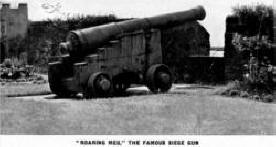 Extraordinarily striking and beautiful views of Derry and its
setting can be seen from the surrounding high hills. From the old
Strabane road and from the hills above the cemetery one sees in fine
panorama the whole city, the river winding down to Lough Foyle. the
distant hills of Benevenagh and the Keady making a beautiful picture.
Visitors will be pleased with te excellence of the hotels and
restaurants, which thus contribute to the appeal of the city, as an
headquarters for touring the County of Londonderry ; it is also the
gateway to Donegal, and as such is an ideal centre for touring that
beautiful county, where some of the most striking mountain and coastal
scenery In Ireland is to be found. Extraordinarily striking and beautiful views of Derry and its
setting can be seen from the surrounding high hills. From the old
Strabane road and from the hills above the cemetery one sees in fine
panorama the whole city, the river winding down to Lough Foyle. the
distant hills of Benevenagh and the Keady making a beautiful picture.
Visitors will be pleased with te excellence of the hotels and
restaurants, which thus contribute to the appeal of the city, as an
headquarters for touring the County of Londonderry ; it is also the
gateway to Donegal, and as such is an ideal centre for touring that
beautiful county, where some of the most striking mountain and coastal
scenery In Ireland is to be found. In the immediate vicinity of the
city there is much of interest and beauty. Within six miles is the
Grianan of Aileach (' The stone house of the Sun') probably one of the
five places marked by Ptolemy on his map of Ireland (A.D. 55). This was
a residence of the Northern Kings of Ireland down to A.D. 1101, when it
was demolished by Murtagh O'Brien, King of Munster. It consists to-day
of a circular stone cashel 77 feet in diameter, with walls in some
places 15 feet thick, terraced inside and pierced by galleries. The view
from the hill on which this monument stands is one of the finest
imaginable, Lough Swilly, surrounded by beautiful mountains, lies at
one's feet, Lough Foyle quite near, Letterkenny and Strabane, and the
whole range of the Derry and Donegal mountains are visible. A pleasant
run is to the Ness Waterfall and Glen, between Derry and Dungiven, and
thence to the Glens of Banagher. All this district is full of beautiful
bogs, glens, mountains.
 Antiquities.
There are now few relics of antiquity within the city boundaries.
The ancient Walls with their interesting bastions and platforms survive,
and on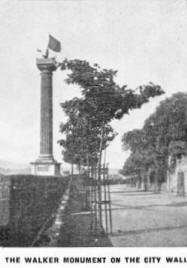 them and along the Quays may be seen many old cannon, the gifts
of the London companies in 1642. S. Columb's Cathedral, completed by the
Irish Society in 1633, contains many relics of the siege and occupies a
commanding site, within the Walls, on the summit of the hill on which
the city is built. them and along the Quays may be seen many old cannon, the gifts
of the London companies in 1642. S. Columb's Cathedral, completed by the
Irish Society in 1633, contains many relics of the siege and occupies a
commanding site, within the Walls, on the summit of the hill on which
the city is built. The building contains many striking memorials,
including the padlocks and keys of the City Gates, locked in the face of
King James's soldiers in 1688, and the staves and portions of silk of
banners, taken from the French b Colonel Michelburne at the Battle of
the Windmill I fill, , May 6th, 1689. The bells in the tower are of
great antiquity, one recast for the Cathedral in 1614, one of 1630, and
five of them having been given by King Charles I. in 1638. In 1929 the
old peal of eight bells was recast, and five new bells added by the Hon.
the Irish Society and others, and in 1933 magnificent entrance gates
were presented by the same society. Just outside the city on the Moville
Road, in the garden at Belmont, is S. Columb's stone, one of the
inauguration stones of the ancient Irish chieftains. It has the
sculptured impression of two feet, and is possibly the stone used at the
inauguration of the Kings of Aileach long before the Christian era
Modern Buildings.
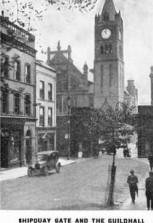 The Guildhall, completed in1912, occupies the site of a previous one
built in 1887 and destroyed by fire in 1908. The first "Town House" was
erected in 1616 in the Diamond, and was destroyed in the Siege of 1689.
The Guildhall contains a splendid series of stained glass windows, many
of them gifts of the London companies, bearing their arms, and
illustrating the history of Derry. Several are War Memorials, gifts of
the Women Voluntary War Workers of Derry. Others were given by members
of the Irish Society, and by prominent citizens. In the Guildhall is the
Corporation Plate, including the Mayor's Medal and Chain of Office, and
the Mace presented by King William III., Mayor's Gold Collarette,
massive Loving Cups and other interesting pieces. Here also is the Sword
of State resented by the Irish Society in 1616, and that of Sir Cahir
O'Doherty. Among the records are the Charter of 1662, the Freemans Roll,
the Corporation Minute Books, and many other documents of historical
value. The Guildhall, completed in1912, occupies the site of a previous one
built in 1887 and destroyed by fire in 1908. The first "Town House" was
erected in 1616 in the Diamond, and was destroyed in the Siege of 1689.
The Guildhall contains a splendid series of stained glass windows, many
of them gifts of the London companies, bearing their arms, and
illustrating the history of Derry. Several are War Memorials, gifts of
the Women Voluntary War Workers of Derry. Others were given by members
of the Irish Society, and by prominent citizens. In the Guildhall is the
Corporation Plate, including the Mayor's Medal and Chain of Office, and
the Mace presented by King William III., Mayor's Gold Collarette,
massive Loving Cups and other interesting pieces. Here also is the Sword
of State resented by the Irish Society in 1616, and that of Sir Cahir
O'Doherty. Among the records are the Charter of 1662, the Freemans Roll,
the Corporation Minute Books, and many other documents of historical
value. St. Eugene's Cathedral is a very fine Gothic building.
dedicated in 1873. It has a beautiful spire, a very sweet Carillon of
Bells, and an east window of splendid pro-portions 54 feet in height and
23 in breadth. Magee College is an admirably equipped and most
flourishing centre of education for those pursuing a University career.
Foyle College has a notable record of famous past pupils, among them
Lord Lawrence, Sir Henry Lawrence, Sir Robert Montgomery and other
heroes of the Indian Mutiny. The High School, Duncreggan, has beautiful
grounds, excellent buildings. and is constantly increasing in number.
and equipment St. Columb's College has a fine educational record, and
has a very large number of boarers and excellent accommodation. The
Craigavon Bridge, connecting the portion of the city on either side of
the river, is by far the largest and finest bridge in Northern Ire-land,
1,200 feet long, 40 feet wide in the roadway, with footpaths 10 feet
wide at the sides, and underneath a subway for rail traffic. It was
erected at a cost of over �250,000, and was opened in state by the Lord
Mayor of London on July 18th, 1933. Londonderry has long been a
garrison city, and now has a spacious and up-to-date barracks.
Sport and Recreation.
There is a fine golf course (18 holes) at Prehen, a mile from the
city on the Strabane Road, in a most picturesque setting above the
river, and at Lisfannon, 10 miles from the city, near Buncrana, are the
popular links of the North-West Club. The city is well provided with
Municipal Bowling Greens and Tennis Courts in Brooke Park. The City of
Derry Boating Club has a distinguished record, including the winning of
the Coronation Cup, presented by the King at Cork in 1911, and the
defeat of the Australian Olympic Crew in the final heat at the Tailteann
Games in Dublin a few years ago. Cricket, football and hockey clubs
abound, and there is a Garrison Drag Hunt in the season. The Cinemas,
too, are numerous and up-to-date, and the facilities for fishing and
shooting in the district are exceptionally good.

County Londonderry.
BY SAM HENRY, F.R.S.A.I.
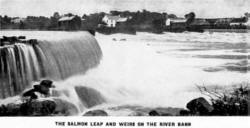 " In Derry Vale beside the singing river,
So oft I strayed, ah, many years ago,
And culled at morn the golden daffodillies
That come with spring to set the world aglow.
Oh, Derry Vale, my thoughts are ever turning
To your broad stream and fairy circled lea.
For your green isles my exiled heart is yearning
So far away across the sea."
�By permission of Novello & Co., LTD I WILL make the County of Londonderry to look like a gentleman," said
Frederick William Aston Hervey, Earl of Bristol and Bishop of Derry. To
a great degree the Bishop succeeded. In no other country are the towns
and villages so uniformly well planned, so clean and attractive as in
the county that lies between the Foyle and the Bann Rivers. There are
Gaelic enthusiasts who would say that the name "London" added to "Derry"
is an unwelcome intrusion in our nomenclature, but they are wrong, for
the finest place-name in our Kingdom�LONDON�at once sonorous, dignified,
meaningful, is a Celtic word meaning "the pool by the fortified hill or
dun." Has not Turner caught on his canvas that pool that gives the
world's capital its name ? Not only has the addition of London to
Derry. -the oakwood,' enhanced the Maiden City's prestige, but the great
Metropolis has been to the County of Londonderry a beneficent mother.
The brain of London is revealed in the architecture and town planning to
which this Bishop of Derry gave the ecclesiastical finishing touch. The
heart of London is manifested in many kindnesses shown to the people and
in the magnanimous provision of free education for three hundred years.
Rivers.
County Londonderry is roughly an equilateral triangle with THE
BANN as its eastern boundary, the sea and Lough Foyle on the north and
the
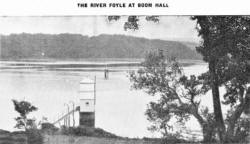 Sperrins on the south-west. The Bann and Foyle are noble rivers.
Both were known to Ptolemy, the third century Greek geographer. The Bann
is a pastoral stream. "Sweet Bann flow gently till I end my song." Known
to Ptolemy as the Argita, "the silver river," this sweet stream has
always been a high-way into Ulster. The first men, when the ice cap
melted ten thousand years ago, found a footing by its banks, as
evidenced by the stone age relics, and bronze age ornaments show that
succeeding races hugged its shores. Its fords are a primer of the past.
It bears in its broad waters a wealth of salmon and eels that have made
it the desire of men of all time, and not least of the monks who once
lived on its banks. St. Patrick taught the people in the Bann vall to
fish by day, and, shall we add, to stop poaching ! This river is a river
of mysteries. Its margin ooze abounds in countless millions of diatoms,
little plants that under the micro-scope dazzle us with their geometric
beauty. These, dying, form the clay (Kieselguhr) that occurs in
commercial quantities in the neighbourhood of Lough Beg and Lough Neagh,
and this is used as a base in the manufacture of explosives and
confectionery. The Bann has splendid waterfalls with scenic beauty round
them�the Salmon Leap, 11 miles south of Coleraine ; Carnroe, nine miles
farther on ; Movanagher, three miles north of Kilrea, and Portna, one
mile south of Kilrea. THE FOYLE, named from a Tuatha-de-danaan prince,
is a noble river Sperrins on the south-west. The Bann and Foyle are noble rivers.
Both were known to Ptolemy, the third century Greek geographer. The Bann
is a pastoral stream. "Sweet Bann flow gently till I end my song." Known
to Ptolemy as the Argita, "the silver river," this sweet stream has
always been a high-way into Ulster. The first men, when the ice cap
melted ten thousand years ago, found a footing by its banks, as
evidenced by the stone age relics, and bronze age ornaments show that
succeeding races hugged its shores. Its fords are a primer of the past.
It bears in its broad waters a wealth of salmon and eels that have made
it the desire of men of all time, and not least of the monks who once
lived on its banks. St. Patrick taught the people in the Bann vall to
fish by day, and, shall we add, to stop poaching ! This river is a river
of mysteries. Its margin ooze abounds in countless millions of diatoms,
little plants that under the micro-scope dazzle us with their geometric
beauty. These, dying, form the clay (Kieselguhr) that occurs in
commercial quantities in the neighbourhood of Lough Beg and Lough Neagh,
and this is used as a base in the manufacture of explosives and
confectionery. The Bann has splendid waterfalls with scenic beauty round
them�the Salmon Leap, 11 miles south of Coleraine ; Carnroe, nine miles
farther on ; Movanagher, three miles north of Kilrea, and Portna, one
mile south of Kilrea. THE FOYLE, named from a Tuatha-de-danaan prince,
is a noble river " Where Foyle his spreading waters rolls northward
to the main.
Here. Queen of Erin's daughters. fair Derry fixed her reign."
Its only tributary from County Londonderry is the Faughan, which,
though small, is the outlet for the rains of a land of rare beauty that
waits to be exploited, particularly by the motorist or the rambler.
THE ROE, "red river," flows through the centre of the county northward
to Lough Foyle. Its valley is the great divide between the basalts on
the east and the schists on the west. Its headstreams in the wild and
fascinating Glenshane Pass and its wooded valley from Dungiven to
Limavady combine to make it unique in scenic charm. The Moyola is a
fairy river, circling the sentinel peak of Slieve Gallion and flowing
through a land of legend and of song to mingle its waters in Lough
Neagh. County Londonderry is a land of little rivers and of little
brooks that
"chatter, chatter as they flow to join the brimming river."

Mountains.
Nor in its rivers alone is this county attractive, but also in its
mountains�lonely giants in the silent wastes.
THE SPERRINS are the
southwest boundary, rising to 2,240 feet in Mount Sawel. When the dying
day spills its Niagara of colour over these great hills, the thoughts
that rise he too deep for tears. Besides the Sperrins another noble line
of hills, THE CARNTOGHERS, runs like a spine through the county. meeting
the Sperrins in the vicinity of Draperstown. It is possible to walk for
fifty miles on hilltops from Downhill to Omagh in Tyrone without being
once in touch with the haunts of men, and where the only company is the
crowing grouse, the bleating sheep, the hovering hawk, and, perchance. a
swooping eagle. The mountain passes, or slacks, lead from beauty to
beauty. The slacks of Faughanvale, Muff Glen, Loughermore, Lissan,
Feeney, Moneyneany, Ballyness, Dunmore and Drumagully, have each a
loveliness of peculiar charm. Londonderry washes about ten miles of
the shore of Lough Neagh, and thus can claim the unusual beauty of this
great Lough, with its peculiar features. Its margins are very shallow.
At times, strange boomings are heard as of distant artillery but really
due to earth movements beneath the lake bottom. It has a fish almost
peculiar to itself�the pollan, which lives on a shrimp that was once a
deep-sea species, and it has a moth on its sandhills that is only found
on dunes by the sea. The ornithologist will find Lough Neagh a paradise
for birds, ducks (at least five species), the great crested grebe,
terns, sandpipers, and the yellow wagtail (only found here and at Lough
Corrib in Galway). As fishing and sport are dealt with elsewhere, it
is our function to show that Londonderry can take her place in the
foreground as a happy hunting ground for the tourist, and, may we add,
the man who is searching for happiness�and who is not ?
Castlerock,
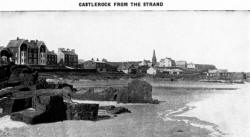 A restful watering place five miles west of Coleraine, is situated
on the pure sands, and within ten minutes' walk of the noble estuary of
the Bann. It has excellent hotels, whose windows are frames for
panoramas of lovely seascapes. There is a championship standard golf
course of 6,000 yards, and good rock and surf bathing. The bird life of
the Bann Estuary and the mudflats up the river are of extreme interest
to the ornithologist, as the Bann is a line of migration for the rare
waders. The sand dunes beyond the golf links and the adjoining townland
of Grangemore have yielded many antiquities of the stone and iron ages.
Close to Castlerock is DOWNHILL and its palatial mansion, where that
eccentric eighteenth century cleric and patron of the arts, the Earl of
Bristol and Bishop of Derry resided. From Downhill a strand seven miles
long extends to the peninsula of Magilligan and the mouth of Lough
Foyle. This is a veritable paradise for the conchologist, 118 species of
shell life having been found in one day, including some very rare
species. The sands are also a popular venue for motor racing. A restful watering place five miles west of Coleraine, is situated
on the pure sands, and within ten minutes' walk of the noble estuary of
the Bann. It has excellent hotels, whose windows are frames for
panoramas of lovely seascapes. There is a championship standard golf
course of 6,000 yards, and good rock and surf bathing. The bird life of
the Bann Estuary and the mudflats up the river are of extreme interest
to the ornithologist, as the Bann is a line of migration for the rare
waders. The sand dunes beyond the golf links and the adjoining townland
of Grangemore have yielded many antiquities of the stone and iron ages.
Close to Castlerock is DOWNHILL and its palatial mansion, where that
eccentric eighteenth century cleric and patron of the arts, the Earl of
Bristol and Bishop of Derry resided. From Downhill a strand seven miles
long extends to the peninsula of Magilligan and the mouth of Lough
Foyle. This is a veritable paradise for the conchologist, 118 species of
shell life having been found in one day, including some very rare
species. The sands are also a popular venue for motor racing.
Inishowen lies across the bay, in sunlight like a patterned quilt, and
in twilight like a cluster of purple grapes are its silent hills. The
peninsula of MAGILLIGAN is a most interesting field for study, and is of
unique beauty. Its people are mostly of Danish descent, as the Danes
once maintained a colony here. The botanist and the entomologist will
also revel in its sand dunes and foothills. It was once known as the
medicine garden of Europe." Magilligan was the home of one of Ulster's
great harpers, Denis Hampson, whose instrument is still preserved. This
district was called after the family of Magilligan, who were the
hereditary farmers of the church lands of the monastery of Duncrun.
Within half a mile St. Patrick and St. Columba founded churches. Here
was St. Columba's favourite church. In the graveyard at Duncrun is one
of the three remarkable oratory-shaped tombs, in this instance
containing the remains of St. Aidan, it being assumed that the relics of
the great Saint of Lindisfarne, were brought here by St. Colman, when he
left Northumbria on the rejection of his tenets in 664 A.D. by King Aldf
rid on the advice of Wilfrid, the King's adviser. Magilligan and the
Lough Foyle littoral are like a little bit of Holland. Over the flat
peninsula looms the fine peak of Benevenagh, on whose slopes Alpine
plants are found and the raven and peregrine nest. About three miles
from Castlerock, on the Coleraine road, is the village of ARTICLAVE,
which is the best starting point from which to visit the Giant's Sconce,
the great fortress of the Red Branch Knights. In the immediate vicinity
in 627 A.D. was fought the battle of Brae Slieve when the Pictish
dynasty was overthrown. It is the centre of a district which was subject
to frequent Danish invasion. There are fifteen souterrains in the
parish.
 Coleraine.
The city with the name-poem " the corner of the ferns" ; yes,
city, for so it was called by St. Bernard of Clairvaux early in the
twelfth century.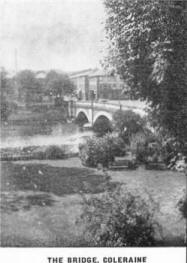 Named by St. Patrick in the middle of the 5th century,
it even then was a town of no mean importance, for it was the capital of
the territory of the Picts, with its royal palace in Dun-da-bheann (Mountsandel)
close by. It is the most interesting fort site in the county, and was
the seat of the royal line of Rory Mor, of the Pictish dynasty about 100
B.C., who, in King Conor's reign as Ard-Righ at Armagh, held sovereignty
over one third of Ulster. The festal pleasures of that royal dun are
described for us in the Mesca Uladh, a section of the Book of Leinster.
It was the king's citadel, but the parade and guard houses extended to
the fields adjoining. This type of dun is only paralleled at Dundermott,
near Clough, Co. Antrim, and is of the type found in Hungary and
Bohemia. The old dun became in the 13th century the site of the castle
of Kilsanctan, and round it many historical incidents took place,
especially in association with Sir John de Courcy, who was virtually Kin
of Ulster about 1200 A.D. Coleraine's first Bishop was Corpreus, who was
educated at the Christian School at Candida Casa at Whithorn in
Galloway. It has always been a town of distinction, one writer calling
Coleraine "A lady of quality among towns." Yet perhaps its fame rests
chiefly on a song " Kitty of Coleraine, published anonymously in 1810 in
a Waterford chapbook. Named by St. Patrick in the middle of the 5th century,
it even then was a town of no mean importance, for it was the capital of
the territory of the Picts, with its royal palace in Dun-da-bheann (Mountsandel)
close by. It is the most interesting fort site in the county, and was
the seat of the royal line of Rory Mor, of the Pictish dynasty about 100
B.C., who, in King Conor's reign as Ard-Righ at Armagh, held sovereignty
over one third of Ulster. The festal pleasures of that royal dun are
described for us in the Mesca Uladh, a section of the Book of Leinster.
It was the king's citadel, but the parade and guard houses extended to
the fields adjoining. This type of dun is only paralleled at Dundermott,
near Clough, Co. Antrim, and is of the type found in Hungary and
Bohemia. The old dun became in the 13th century the site of the castle
of Kilsanctan, and round it many historical incidents took place,
especially in association with Sir John de Courcy, who was virtually Kin
of Ulster about 1200 A.D. Coleraine's first Bishop was Corpreus, who was
educated at the Christian School at Candida Casa at Whithorn in
Galloway. It has always been a town of distinction, one writer calling
Coleraine "A lady of quality among towns." Yet perhaps its fame rests
chiefly on a song " Kitty of Coleraine, published anonymously in 1810 in
a Waterford chapbook. This town has enjoyed the benevolent sway of the
Irish Society of London for over three hundred years, and has reaped the
benefit of superior education, fine public buildings, and generally has
had a high level of social life. Coleraine was the home of the Lawrences
of Indian fame, and of the artists, Hugh Thomson, that gentle artist of
the delicate pencil, and Arthur David McCormick, the incomparable
painter of mountain scenery. Two miles south of Coleraine is CASTLEROE,
more correctly Castle Rose�the castle of Rose O'Cahan. It is the site of
the famous Salmon Fishery at the Salmon Leap in the most royal reach of
the noble river Bann. Three miles west of Coleraine on the road to
Limavady is the tiny village of MACOSQUIN, the plain of the clear
water." It has a great history, for here a Cistercian monastery was
founded in 1172 and its Abbot, John, became Bishop of Derry. The road
leading from Macosquin across the mountain gives scenic prospects of
mountain, moor and sea that are on a spacious scale, the first view of
the Foyle from,. the mountain top "bidding the rash gazer wipe his eye."
To-day the Borough of Coleraine is one of the most thriving business and
market towns in Ulster. It is a good centre too for sport, for services
of trains and omnibuses take one, within 20 minutes, to the golf links
at Portrush, Portstewart or Castlerock. There are also tennis courts and
bowling greens, and the Bann itself is famous for its rowing regattas.

Dungiven,
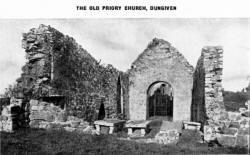 Situated in the valley of the Roe, is rich in ecclesiastical and
historical interest, and stands in the midst of a lovely landscape of
mountain, glen and stream. The fine peak of Benbraddagh looks down on it
from the east, and to the south a cluster of mountains rising to Sawel
and its twin peak, Dart, give endless vistas of valley and hill. The
town is one of the best centres for fishing on the Roe and its
tributaries. Situated in the valley of the Roe, is rich in ecclesiastical and
historical interest, and stands in the midst of a lovely landscape of
mountain, glen and stream. The fine peak of Benbraddagh looks down on it
from the east, and to the south a cluster of mountains rising to Sawel
and its twin peak, Dart, give endless vistas of valley and hill. The
town is one of the best centres for fishing on the Roe and its
tributaries. The London Company of the Skinners were the influence
here, and in its beautiful surroundings the old families of Ashe,
Dodington, Cooke, Beresford, and Ogilby chose their homes. This land had
its Robin Hood in the person of Shane Crossagh, who lived about 200
years ago, and whose exploits still form the theme of fireside stories
in the glens. About four miles south-west of Dungiven on the road to
Londonderry is the typical lime-washed Irish village of FEENY. Near here
is The General's Bridge, where the aforementioned Shane Crossagh held up
General Napier with dummy troops. Three miles south of Feeny we come to
PARK, a romantic village embosomed in the woods of Learmount. The
settlers under the Plantation scheme knew where the beauty spots of the
county were, and in the vicinity of Park there is the castle of the
Beresfords, descendants of Sir Tristram Beresford, the first agent of
the Irish Society of London. The finest sculptured tomb in the north
is to be seen in the Priory Church, being that of Cooey-na-Gall terror
of the stranger"), who was a chieftain of the O'Cahans in the 13th
century. Eight miles west of Dungiven is CLAUDY, a village famed for
its fairs. It is the key to the beauty of the Sperrin valleys and
mountain scenery, which is a land of unspoilt beauty. Twenty little
rivers laugh through this bright land. Garvagh,
11 miles south of Coleraine on the road to Maghera, is a pretty
town set amid undulating hills, on the outskirts of the Carntogher
mountains. with the Errigal river flowing through. The dominating
influence here was the Canning family, of which George Canning was
Foreign Secretary and Prime Minister of England in the early 19th
century. There are fine fishing rivers in the vicinity, the Errigal
being the best salmon spawning river in the Bann valley. It is also an
interesting centre for the antiquarian. At Slaghtaverty, about two miles
S.E. of Garvagh, is a dolmen which marks the grave of Abhartach, dwarf,
magician and musician, son of Aitherne, a first century poet laureate of
Ulster. On the eastern slope of Carntogher Mountain in the townland of
Knockoneill are dolmens and the stone circle marking the grave of Niall
Glundubh. At Moneydig, three miles east of Garvagh, there is a perfect
example of a burial chamber, known as The Daff." It is small, but the
stonework is fitted so exactly that it is worthy of a visit. In
Ballyrogan Bog, two miles N.W. of Garvagh, a cauldron of the 5th Bronze
Age (800 to 350 B.C.) was found. Four miles north of Garvagh is
AGHADOWEY, which means " Duffy's field," possibly from Dubhtach, Abbot
of Derry, who died in 936 A.D. At one time there were eleven bleach
greens in this smiling wooded district. From here in 1718 an extensive
emigration to New England was led by its minister, Rev. James McGregor.
Kilrea,
A fine, clean town, set on a hill overlooking the Bann Valley and near a
cluster of little wood-embowered lakes, is one of the best known fishing
centres in Ulster. In its vicinity the rare orchis, Irish Ladies
Tresses. is found. It has associations with famous men�Rev. Matthew
Clerk, a pioneer minister of the settlement of Cherryfield in New
Hampshire in 1728 ; Father Dolling, well-known in London for his
humanitarian activities ; the brothers Glasgow, one of whom, a famous
portrait painter, painted Queen Victoria ; the other was known for his
grandfather clocks. It is of interest that during the present great Bann
drainage scheme dredging and excavations have disclosed in this vicinity
many articles of extreme interest to the antiquary, chiefly of the
Bronze and Copper Ages. Seven miles south of Kilrea, partly in Co.
Antrim and partly in Co. Derry, is the pleasant village of PORTGLENONE,
near to which the remarkable diatomaceous clay or Kieselguhr is found.
 Limavady,
Meaning " The Dog's Leap," from a traditional dog of O'Cahan, the
chieftain, which jumped the Roe and conveyed a message hidden below its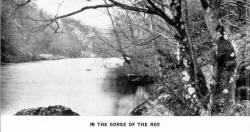 collar to the Dungiven branch of the sept, and thus was instrumental in
bringing needed help. In the Plantation of Ulster, the immediate
district around Limavady was given to the Kings agent, Sir Thomas
Phillips, for "a cabbage garden," and Castledawson for his "duck-pond."
collar to the Dungiven branch of the sept, and thus was instrumental in
bringing needed help. In the Plantation of Ulster, the immediate
district around Limavady was given to the Kings agent, Sir Thomas
Phillips, for "a cabbage garden," and Castledawson for his "duck-pond."
The valley of the Roe is of surpassing beauty, with deep gorges in the
schistose rocks and wooded banks. Near Limavady is the mound of
Drumceatt ("the whale's back" from its shape) in Roe Park, at Mullagh
Hill, once known as Gortinanima "the garden of the soul." It is hallowed
ground, for there in 575 A.D. a convention was held under the presidency
of St. Columba, which determined the future of the Kingdom of Scotland,
and there Columba baptised baby Domhnail who was to overthrow the Picts
in 627 A.D. Even prior to this great convention it must have been a
sacred site judging by the tumuli and sepulchral mounds which have been
found there.
Near Limavady, at Drumrammer, was born St. Canice, the great saint,
after whom Kilkenny is named, and who founded St. Andrew's in Fife. It
was here, too, in more recent days that Thackeray wrote his well-known
poem " Peg of Limavady," and where that great Premier of New Zealand, W.
M. Massey, was born and educated. It is of interest that The
Londonderry Air," pronounced to be the finest melody in existence, was
collected in Limavady by Miss Jane Ross in 1851, the then player being
an itinerant fiddler named McCormick. Evidence points strongly to its
author having been Rory Dail O'Cahan, described as " Lord of the Route
and Limavady," who was the prototype of Rory Dail McMurrough in chapter
22 of Scott's "Waverley." A short distance from Limavady on the road
to Londonderry is the little village of BALLYKELLY, which has a parish
church with a graceful spire, erected by the aid and guidance of the
Earl of Bristol�Bishop of Derry. The fine wood of Walworth, containing
some of the aboriginal timber of the country, is named for Sir William
Walworth, a Governor of the Fishmongers Company of London, who, with his
own sword, slew Wat Tyler, the rebel, in London. Nearer Londonderry is
EGLINTON, probably the most picturesque village in the county. It bears
every sign of the cultured influence of the London Company of the
Grocers. It is quite English in its appearance, embowered in magnificent
trees and with old world cottage gardens. It was formerly called "
Muff," but changed its name in 1858 in honour of the then Lord
Lieutenant of Ireland, the Earl of Eglinton. It is at the entrance of
the beautiful Muff Glen, which extends southwards and the road through
which leads over Highmoor to the Ness Waterfall, the finest in the
county, formed by the Burntollet river, which flows through a wide glen,
once the hiding place of the highwayman Shane Crossagh�a glen of open
glades and fantastic schistose rocks. Northwards of Limavady is the
charming little hamlet of BOLEA, in the valley of the Curly Burn. In
this neighbourhood are the Dooans, a site of ancient funeral games, and
by the stream is one of the few remaining examples of "the
sweathouse,"an ancient form of Turkish bath. Also in this direction and
on the coast road to Coleraine is BELLARENA, a centre of one of the most
charming districts of Ulster. The splendid basalt cliffs of Benevenagh
rise sheer to 1250 feet. The rock stacks, where the raven and peregrine
nest, rise above the woods and from the top can be seen the pencilled
plain of Magilligan lying below, the waters of Lough Foyle, the Atlantic
Ocean, and the Inishowen Peninsula.
 Maghera,
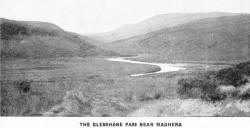 " The field of the solemn vespers," is ecclesiastically considered
a place of venerable antiquity. In the fifth century, St. Lurach (or
Lowry) founded a church here. The 12th century structure that stood on
the original site, though now a ruin, has the finest sculptured doorway
in Ulster, representing the Crucifixion in crude but striking detail. " The field of the solemn vespers," is ecclesiastically considered
a place of venerable antiquity. In the fifth century, St. Lurach (or
Lowry) founded a church here. The 12th century structure that stood on
the original site, though now a ruin, has the finest sculptured doorway
in Ulster, representing the Crucifixion in crude but striking detail.
In the vicinity are Tirnoney dolmen, Tirkane sweat-house, and the ruins
of the ancient churches of Killelagh and Mullagh (Termoneeny). Maghera
has produced famous men. Dr. Adam Clarke, the great commentator, was
born at Moybeg, and Dr. Henry Cooke, a famous Presbyterian divine, was a
native of the vicinity, and Charles Thomson, the framer of the
Declaration of American Independence, was of Maghera origin. Two miles
south of Maghera, in the valley of the Moyola, is TOBERMORE, which means
"the great well." Here was the church of St. Cronaghan, the tutor of St.
Columba when a boy. Also in the sweet vale of Moyola, and under the
lee of Slieve Gallion, is DRAPERSTOWN, of historic interest as the
centre of a district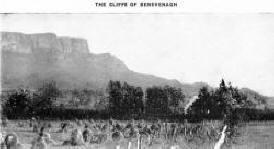 occupied by the victorious Collas, three brothers
who came from Roscommon and are buried on the slopes of the mountain.
St. Patrick founded a library at Ballynascreen (the parish in which
Draperstown stands), but St. Columba transformed it into a church. The
London Company of the Drapers did much to make this town architecturally
distinguished. It is far in advance of the usual Irish town in planning
and solidity and symmetry of buildings. occupied by the victorious Collas, three brothers
who came from Roscommon and are buried on the slopes of the mountain.
St. Patrick founded a library at Ballynascreen (the parish in which
Draperstown stands), but St. Columba transformed it into a church. The
London Company of the Drapers did much to make this town architecturally
distinguished. It is far in advance of the usual Irish town in planning
and solidity and symmetry of buildings. Southwest of Draperstown lies
the district known as THE SIXTOWNS. They are the herenach or church farm
lands of Ballynascreen parish. This was the centre of the legendary
feats of the giant Finn MacCool and many heroes of the Celtic romance
period. Magherafelt,
" The plain of the rushes," is a fine market town, spaciously planned
and of architectural prestige due to the influence of the Salters'
Company of London, whose castle stood originally in the Diamond. It is a
convenient centre for pleasant runs by Lough Neagh, Carndaisy Glen and
other scenic spots. On the shores of Lough Neagh, near Magherafelt, is
the village of BALLYMAGUIGAN, where there was formerly a Moravian
settlement, whose descendants still people that district, also
BALLYRONAN, once a thriving little port on the west side of Lough Neagh,
largely the result of the enterprise of the Gaussen family of Huguenot
descent. The land was in the Salters' territory, and was known as the
Manor of Sal.
South of Magherafelt is the fine market town of MONEYMORE, and
northwards BELLAGHY, the old home of the Downings, a Devonshire stock,
whose influence is still seen and felt in the district. Near Lough Beg,
at Ballyscullion, once stood a palatial mansion of the Earl of Bristol,
Bishop of Derry. Its portico now forms the entrance to St. George's
Church, Belfast.
Portstewart,
To the west of the estuary of the River Bann, is ideally situated
on the slope of a hill, semi-circular in shape. Its spacious promenade
overlooks one of the most beautiful little bays in Ulster ; at one end
nestles the Harbour and at the other towers the grim and gaunt castle of
O'Hara. Beyond this, for about half-a-mile, are some majestic cliffs,
round the top of which a walk has been constructed, and then commences a
magnificent stretch of golden sand, extending for two miles to the mouth
of the River Bann. Perhaps one of the most essential features of
Portstewart is its wonderful climate and salubrious air which is simply
laden with the ozone of the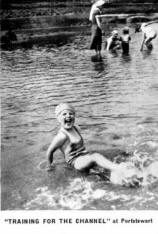 Atlantic Ocean, giving it a highly bracing
effect, yet it i.s soft and silky, the result being a delightful feeling
of exhilaration. Atlantic Ocean, giving it a highly bracing
effect, yet it i.s soft and silky, the result being a delightful feeling
of exhilaration. Portstewart is deservedly one of the most popular and
progressive seaside resorts in Ulster, as it caters exceptionally well
for the holiday-maker. Good accommodation is available to suit every
requirement ; its bathing facilities are one of its chief attractions�a
morning plunge in " The Herring Pond " or at " Portna-happle "
exhilarates to a marvellous degree, and at the Crescent�just at one end
of the Promenade�facilities are available for non-swimmers and " The
Toddlers," and the delights of surf bathing can be enjoyed to the utmost
at the stretch of sand referred to previously. Public tennis courts are
provided, and there are two excellent golf links�both of 18 holes. Apart
entirely from the sporting qualities of each of these links, their ideal
situation commends them to all. The shorter links is only a few minutes'
walk from the centre of the town and is greatly patronised by ladies and
those preferring a short round. The championship links is about
three-quarters of a mile from the town, to which frequent transport
services are maintained. It is one of the finest and most sporting
courses in Ulster. All these amenities combine to make Portstewart a
place of charm with a personality of its own which draws its visitors
again and again.
The resort makes a convenient centre from which to visit the Giant's
Causeway, Carrick-a-Rede Rope Bridge, Magilligan, the Glens of Antrim,
the City of Derry, and the inland portions of County Derry.
Portstewart is keeping thoroughly abreast of the times, and has now
added to its many attractions an up-to-date and suitable Town Hall. In
addition, a large number of superior residences have been recently
erected or are in course of erection on the seaward sides of the town.
Sir George White, of "Ladysmith" fame, was born at Rockport, between the
town and the Strand, and the name of Charles Lever, the famous Irish
author, is intimately associated with the district, for here he was
dispensary doctor. His Lorrequer novels are said to contain the finest
descriptions of military life that were written, and in his " Knight of
Gwynne" there are many allusions to Portstewart and its people, and in
fact many of the anecdotes recorded therein had their origin in this
district, including the feat of jumping over horse and cart which Lever
attributed to Charles O'Malley, at Lisbon, but was really accomplished
by himself in the town of Coleraine.
 |